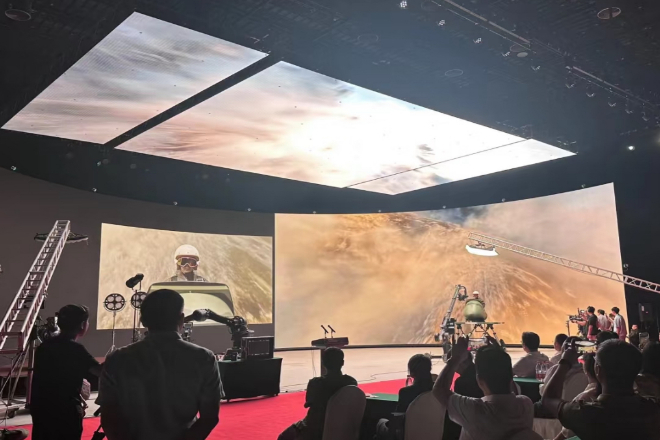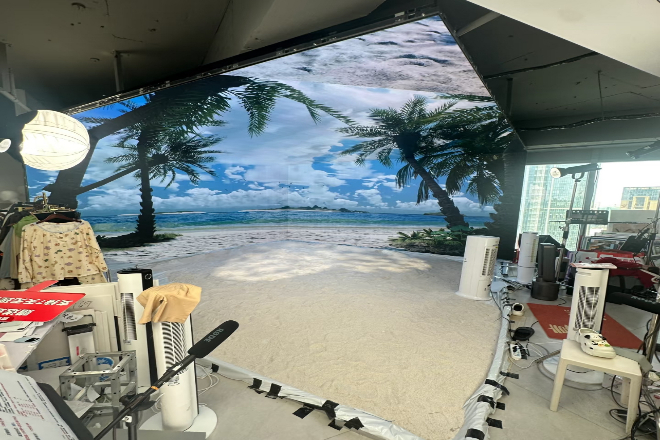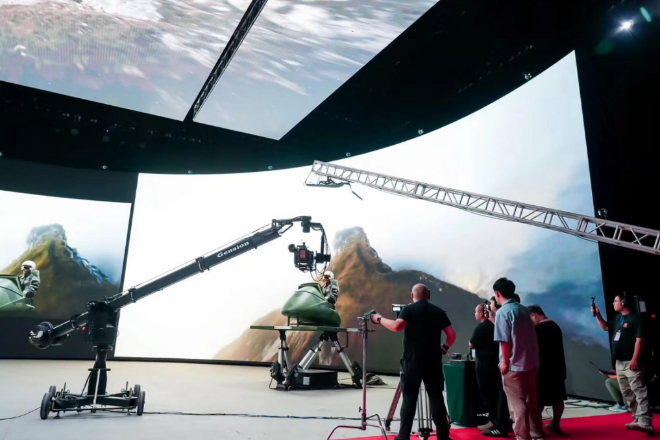Introduction
As the audience’s requirements for the quality of live broadcast content and viewing experience are increasing, traditional live broadcast forms can no longer meet their needs.
Immersive live broadcast, as an emerging live broadcast method, is attracting more and more viewers and anchors with its unique charm and unlimited potential.
As a key device for creating an immersive live broadcast room, an LED large screen has brought unprecedented viewing experience to the audience. So, as an anchor, how can you use a large LED screen to create an immersive life live broadcast room?
1. A brief introduction to immersive life live broadcast room

Immersive life live broadcast room is a form of live broadcast that makes you feel like you are at the scene in person and interact with the anchor at close range.
It uses high-definition LED large screens, virtual scene technology, and cool lighting and sound effects to allow you to enjoy an immersive viewing experience at home.
1). Detailed explanation of the core elements of immersive life live broadcast room:
- High-definition LED large screen:
This is not an ordinary screen. It is ultra-high-definition and ultra-delicate, just like moving the scene directly to your eyes. Whether it is the host’s smile or the color of the food, you can see it clearly, making you feel like you are there.
- Virtual scene technology:
Imagine that the host is broadcasting live under the Eiffel Tower in Paris, and you are at home, but you feel like you are walking in Paris with the host. This is the magic of virtual scene technology, which allows you to cross time and space and experience all kinds of impossible scenes.
- Lighting and sound effects:
Good lighting and sound effects are like adding a layer of “filter” to the live broadcast, making the atmosphere more real and more moving. Whether it is a warm family gathering or a lively street performance, you can feel like you are there through the contrast of lighting and sound effects.
2). Features of immersive life live broadcast room:
- Fort impact visuel :
The picture effect brought by the high-definition LED large screen is as shocking as watching a movie. Every detail is clearly visible, making you unable to move your eyes away.
- Forte interactivité :
In the immersive life live broadcast room, you are no longer a simple audience but can participate in the live broadcast. Through virtual scene technology, you can interact with the anchor, chat with other viewers, and play games, which makes you feel like you are gathering with friends.
- Un contenu riche et diversifié :
The content of the immersive life live broadcast room is varied. There is nothing that the anchor cannot broadcast. Food making, home decoration, travel experience… As long as it is a life scene that you are interested in, you can find it here.
Moreover, because of the existence of virtual scene technology, the anchor can also take you to experience some places you have never been to, which will broaden your horizons.
In short, the immersive life live broadcast room is a form of the live broadcast that makes you feel like you are there in person, interact with the anchor at close range and enjoy an immersive viewing experience. It uses high-tech means to allow you to experience various impossible scenes and content at home, making your life more colorful.
Step 1: Preliminary preparation
1). Clarify goals and needs
- Determine the content direction:
First, you have to think carefully about what your live broadcast content is, is it a cooking show, travel sharing or home decoration? Then, determine the overall style and equipment required for the live broadcast room based on the content.
For example, cooking live broadcast may require a warm and comfortable kitchen background; travel sharing may require some decorations with regional characteristics.
- Choose the right technical parameters:
Next, you have to carefully select the size, résolution, fréquence de rafraîchissement, and other parameters of the LED screen. The screen should be large enough so that the audience can see more details.
The resolution should be high so that the picture can be clear and realistic; the refresh rate should be fast so that the picture can be smooth.
- Planning and layout:
Finally, you have to plan the overall layout of the live broadcast room.
Think about where the big screen should be placed so that the audience can watch it most comfortably, how the anchor’s activity area should be set up to facilitate interaction, and how the audience’s interactive area should be arranged so that everyone can participate.
All of these must be planned in advance to ensure that the live broadcast process is smooth and unobstructed.
2). Venue selection and layout
- Find a good place:
It is very important to find a place with sufficient light and sufficient space for the live broadcast room. Sufficient light can make the picture brighter and clearer; a large enough space can accommodate all equipment and personnel, making the live broadcast smoother.
- Decorate the live broadcast room:
Then, you can start to arrange the live broadcast room! Choose the decoration style according to the content of the live broadcast: simple and modern, retro and romantic, or exotic. Don’t forget to add some lighting effects to make the live broadcast room more atmospheric.
You can also set up some background boards, props, etc., to make the live broadcast room more lively and interesting.
Step 2: Equipment selection and installation

1). Equipment selection and installation
- LED large screen selection:
You have to choose a large LED screen with a super high refresh rate, bright enough luminosité, and super-resolution. Only in this way can the audience enjoy it. The picture is clear and smooth, and the details can be presented.
You also have to consider energy saving and easy maintenance. After all, for long-term use, the energy consumption cannot be too high, and it must be easy to repair if it breaks. So when choosing, you have to ask the seller about these aspects.
- Live broadcast equipment configuration:
In addition to the large LED screen, you also have to have a high-definition camera. This camera must be able to capture clear details so that the audience can see every movement and every expression.
The sound card and mixer must also be professional. The sound must be clear, and there must be no noise so that the audience can listen comfortably. Especially when the anchor speaks, make sure that the sound is clear and discernible.
You must also choose a good microphone. The anchor’s voice must be transmitted through the microphone, so the quality of the microphone is very important. You have to choose a microphone that can make the host’s voice sound beautiful and clear.
- Equipment installation and debugging:
After buying the equipment, you have to find a professional to install it. They know how to install it to be stable and look good.
After installation, you have to debug it. You have to make sure that the equipment works well together and there are no problems during the live broadcast. For example, whether the large screen displays normally, whether the camera takes clear pictures, and whether the sound is transmitted well, all these must be debugged before you can start the live broadcast.
2). Site selection and layout
- Find a good place:
Find a place with good light and a large space to make a live broadcast room. Good light makes the picture bright; a large space can put down all the equipment, making the host and the audience comfortable.
- Decorate the live broadcast room:
Decorate the live broadcast room according to the content of the live broadcast. If it is a cooking demonstration, you can put some kitchen utensils and ingredients; if it is a chat interaction, you can put some sofas and coffee tables.
If it is playing games, you can put some game controllers and headphones. You can also add some lighting effects to make the live broadcast room look cooler!
Step 3: Content planning and production
1). Creative conception
1.1). Determine the theme and audience:
Clarify the theme of the live broadcast, such as “Future Home Life Experience”, and ensure that the theme is consistent with the immersive characteristics of the LED display screen, and can fully demonstrate its high-definition, dynamic and interactive advantages.
Analyze the needs and interests of the target audience and understand their preferences in technology, home, quality of life, etc., so as to better meet their expectations in content planning.
1.2). Conceive the content framework and the use of an LED display screen:
Conceive the general framework of the live broadcast, including the opening introduction, the main content display (such as the demonstration of future home appliances, the simulation of life scenes, etc.), the interactive link (audience questions, voting, etc.), and the ending summary (reviewing the highlights of the live broadcast and thanking the audience for participating).
Clearly define the use of the LED display screen in the framework. In the beginning, you can use the LED display to play dynamic background videos to create a future technology atmosphere; when the main content is displayed, the LED display is used as the main display platform to display the details of home appliances in high-definition and dynamically demonstrate the usage scenarios.
During the interactive session, the LED display is used as an interactive interface to present audience questions and voting results; at the end, the LED display is used again to play the summary video to deepen the audience’s impression.
1.3). Refine the content points and integrate with the LED display:
In the main content display part, refine the demonstration link of each home appliance. For example, for the smart lighting system, you can show its functions, such as voice control and mobile phone APP remote control, and use the LED display to show the changes in lighting effects in high definition so that the audience can intuitively feel its convenience and beauty.
In the interactive session, design some interactive games or questions and answers closely related to the LED display. For example, you can set up a “spot the difference game” to display two similar home scenes on the LED display and let the audience find the differences.
Or set up a “home knowledge question and answer” to present questions on the LED display, and the audience can answer through bullet screens or comments, and those who answer correctly can get small gifts.
2). Content production
2.1). Prepare materials to adapt to the LED display:
According to the creative concept, the required video, audio, picture, and other materials must be collected or produced. Ensure that the resolution and frame rate of the video material match the parameters of the LED display to ensure clear and smooth images.
The audio material should be clear and noise-free and coordinated with the content of the picture; the picture material should be high-definition and beautiful, and in line with the live broadcast theme.
Prepare some special materials for the characteristics of the LED display. For example, make some dynamic background videos for the opening and ending parts; design some interactive interface elements, such as question boxes, voting buttons, etc., for interactive links.
2.2). Video editing and LED display integration:
Professional video editing software is used to edit and splice the materials according to the creative concept. Pay attention to the beauty and smoothness of the picture to ensure that the audience can enjoy a good visual experience when watching.
In the editing process, fully consider the display effect of the LED display.
For example, when demonstrating home appliances, you can combine the display content on the LED display with the actual scene through lens switching, picture overlay, etc., so that the audience can understand the use and effect of the equipment more intuitively.
2.3). Audio processing and atmosphere creation:
Process the audio in the live broadcast to ensure its clarity and sound quality. You can add some background music or sound effects to enhance the atmosphere and appeal of the live broadcast.
Select audio materials that match the content displayed on the LED display.
For example, when showing the future home scene, you can choose some background music with a strong sense of technology; in the interactive session, you can add some cheerful sound effects to create a relaxed and pleasant atmosphere.
2.4). Preview, test, and adjust:
During the production process, constantly preview and adjust the content to ensure that it meets the expected effect. Especially for the display effect on the LED display, it is necessary to ensure that the picture is clear, the colors are bright, and the dynamics are smooth.
Carry out field tests to simulate the live broadcast environment and check whether the brightness, contrast, refresh rate, and other parameters of the LED display meet the live broadcast requirements.
At the same time, test whether the functions of the interactive session are normal, such as whether the audience’s questions can be displayed in real-time and whether the voting results can be accurately counted. Make necessary adjustments and optimizations based on the test results.
3). Content preview and optimization
3.1). Comprehensive preview and LED display effect evaluation:
Before the live broadcast, conduct a comprehensive preview of the entire content, paying special attention to the display effect of the LED display. Check whether the picture is clear and smooth, the color is accurate, and the dynamic effect is natural.
At the same time, evaluate the role and effect of the LED display in the live broadcast to ensure that it can bring an immersive viewing experience to the audience.
3.2). Troubleshooting and optimization adjustment:
If problems are found during the preview process, such as the LED display screen freezes, color distortion, abnormal interactive functions, etc., promptly investigate the cause and make optimization adjustments.
You can adjust the settings of the LED display, such as adjusting parameters such as brightness, contrast, refresh rate, etc.; or replace more suitable materials to optimize the display effect; or repair and improve the functions of the interactive link.
3.3). Final confirmation and preparation:
After optimization and adjustment, preview the content again to ensure that everything is ready. In particular, the display effect of the LED display should be in the best state, and the functions of the interactive link should be available normally.
At the same time, confirm the details of the live broadcast time, location, equipment (including LED display) to ensure the smooth progress of the live broadcast. Bring the audience a future home life live broadcast experience full of technology and immersion.
Step 4: Implementation of immersive live broadcast

1). Virtual scene technology integrated with LED screen
1.1). Technical preparation and scene creation:
We must first get the virtual scene technology right, which can simulate various realistic life scenes.
Then, combined with the ultra-high-definition display effect of the LED screen, the virtual scene is vividly presented. Designers will use their brains to come up with some scenes that are both in line with the theme of the live broadcast and can fully demonstrate the charm of the LED screen.
1.2). Interactive experience between the anchor and the scene:
The anchor is like walking into another world and can walk freely in the virtual scene. For example, cooking in the virtual kitchen, chatting with the audience in the virtual living room, and even dancing on the virtual stage.
Through some high-tech tracking technology and real-time rendering, the anchor’s movements and expressions can be perfectly integrated with the virtual scene, making the audience feel like they are also on the scene.
1.3). Improved audience immersion:
We will constantly adjust the angle and details of the virtual scene to ensure that the audience feels real from any angle.
At the same time, we will also consider whether the audience’s eyes are comfortable, avoid the picture being too dazzling or too messy, so that the audience can watch the live broadcast comfortably and enjoy the immersive fun.
2). Clever combination of lighting and sound effects
2.1). Thoughts on lighting design:
Lighting is a master at creating atmosphere. We will carefully design the lighting plan according to the content and theme of the live broadcast.
For example, for a food broadcast, warm-toned lighting is used to make the audience feel like they can smell the fragrance of food; for a technology product display, cool-toned lighting is used, and some technological sound effects are added to make the product cooler.
2.2). Selection and use of sound effects:
Sound effects cannot be ignored. We will select some background music and sound effects that match the live broadcast content to make the audience more engaged.
When chatting casually, play some cheerful music to make the audience feel that the host is very friendly; when there is an interactive session, add some suspenseful sound effects to make the audience more excited.
3). Design and implementation of interactive sessions
3.1). The fun of audience voting:
Audience voting is a very fun way to interact. During the live broadcast, we can set up some voting sessions to let the audience choose topics they are interested in.
The voting results are displayed in real-time on the LED screen, so the audience can see how their choices affect the live broadcast, feel more involved, and have a greater sense of belonging.
3.2). Surprise of lucky draw:
Lucky draws are also a good way to attract viewers. During the live broadcast, we can regularly draw prizes and give small gifts or coupons to the audience.
The lucky draw process and results are displayed on the LED screen, making the audience feel fair and transparent, as well as more expectant and excited.
3.3). More creative ideas for interactive sessions:
In addition to voting and lucky draws, we can also think of other interactive sessions, such as quiz games, talent shows, etc.
These sessions can make the live broadcast more interesting and diverse, and can also allow the audience to participate more deeply and establish a closer connection with the anchor. In this way, the live broadcast will be more lively and fun!
Conclusion
Through the explanation of this article, we have a deep understanding of how to use LED screens to create an immersive life live broadcast room. From pre-preparation to equipment selection, from content planning to post-optimization, each link is crucial and together constitutes a complete system of immersive live broadcast rooms.
As the core equipment of the immersive live broadcast room, the importance of a large LED screen is self-evident. It not only provides high-definition and delicate picture effects but also brings an immersive viewing experience to the audience.
Enfin, si vous souhaitez en savoir plus sur les écrans d'affichage LED, Contactez nous s'il vous plait.
